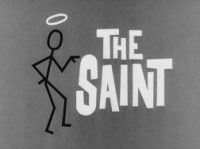
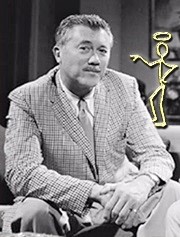 The Saint (1945, 1947-51) aired “The Case of the Blonde Who Lost Her Head” first on May 26, 1948, as the 43rd episode of the 1947 run with Vincent Price as The Saint, and then again on November 13, 1949. This repeat airing is the one you will hear here, thus the PSA (Public Service Announcement) at the end calling for food contributions for those still in need in Europe after the end of WWII, and a week before Thanksgiving here in America. We have run only five previous episodes of this fine show, the last being in November of 2019, almost two and a half years ago. For new listeners I now borrow freely from that show’s opening remarks as they deal with the creator and partial history of The Saint on radio, in print, and on film. It is estimated there were in the neighborhood of 157 unique (i.e., original) episodes (depending on which historian you talk to) of which approximately 57 are in circulation.
The Saint (1945, 1947-51) aired “The Case of the Blonde Who Lost Her Head” first on May 26, 1948, as the 43rd episode of the 1947 run with Vincent Price as The Saint, and then again on November 13, 1949. This repeat airing is the one you will hear here, thus the PSA (Public Service Announcement) at the end calling for food contributions for those still in need in Europe after the end of WWII, and a week before Thanksgiving here in America. We have run only five previous episodes of this fine show, the last being in November of 2019, almost two and a half years ago. For new listeners I now borrow freely from that show’s opening remarks as they deal with the creator and partial history of The Saint on radio, in print, and on film. It is estimated there were in the neighborhood of 157 unique (i.e., original) episodes (depending on which historian you talk to) of which approximately 57 are in circulation.
Crime and mystery novelist Leslie Charteris’ (photo top right, 1907-1993) famous detective Simon Templar was dubbed The Saint by the underworld, though he was hardly what the monicker implied. The story goes that he came by the name because of his initials, S. T.. The Saint, as a radio show (there were movies, tv shows, novels, and even comic books), ran first in 1945, and then from 1947-1951, with almost all episodes featuring the incomparable Vincent Price (photo lower right, 1911-1993). Before Price assumed the role of The Saint, there were two others before him, beginning with the 1945 run: Edgar Barrier (January-March 1945) and Brian Aherne (June-September 1945). With the rare episode where actor Barry Sullivan would fill in, Vincent Price was the voice of The Saint from July 9, 1947 through May 20, 1951. The final 22 episodes after Price departed saw actor Tom Conway as The Saint, from May 27, 1951 through October 21, 1951.
The first Saint novel was published in 1928 when Charteris was just shy of his 21st birthday and was titled Meet the Tiger. In later years Charteris practically disowned the novel, remarking that it was so poorly written he wondered how it ever got published. Instead, he preferred to count 1930’s second Saint novel Enter the Saint as the first true Saint novel. Be that as it may, he would write Simon Templar  adventures (novels, short stories, and novellas) off and on for the next 33 years, the final Saint book written solely by himself being a collection of stories in 1963 titled The Saint in the Sun. Thereafter, all of the Saint titles would be ghost-written but credited to Charteris, who remained in an editorial capacity, reading the manuscripts and editing where necessary. Of interest to science fiction readers is that the first of the ghost-written Saint novels was written by none other than Harry Harrison (1925-2012, SFWA Grand Master 2009, photo at left), and was 1964’s Vendetta for the Saint. Harrison, also an illustrator early in his career (the legendary Wally Wood would ink Harrison’s pencils for several SF comics, among them Weird Fantasy and Weird Science), also wrote the syndicated The Saint comic strip.
adventures (novels, short stories, and novellas) off and on for the next 33 years, the final Saint book written solely by himself being a collection of stories in 1963 titled The Saint in the Sun. Thereafter, all of the Saint titles would be ghost-written but credited to Charteris, who remained in an editorial capacity, reading the manuscripts and editing where necessary. Of interest to science fiction readers is that the first of the ghost-written Saint novels was written by none other than Harry Harrison (1925-2012, SFWA Grand Master 2009, photo at left), and was 1964’s Vendetta for the Saint. Harrison, also an illustrator early in his career (the legendary Wally Wood would ink Harrison’s pencils for several SF comics, among them Weird Fantasy and Weird Science), also wrote the syndicated The Saint comic strip.
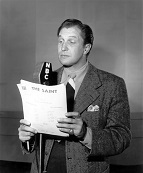 Simon Templar falls into the camp of the “soft-boiled” detective, in line with such as Nero Wolfe, Sherlock Holmes, and Dashiell Hammett’s Nick Charles (who prefer solving crimes with their wits rather than their fists), as opposed to the “hard-boiled” branch of the detective tree and the likes of Sam Spade, Phillip Marlowe, and Boston Blackie. The iconic stick figure with halo representing The Saint was first introduced in the early stories as a calling card Templar would leave so that his enemies would know who was responsible for their downfall. The title card/logo at top left was used in the 1960’s The Saint tv series starring future James Bond star Roger Moore. The tv series originated in the UK and ran from 1962-69, but was picked up by NBC in America and ran as a summer replacement in 1966.
Simon Templar falls into the camp of the “soft-boiled” detective, in line with such as Nero Wolfe, Sherlock Holmes, and Dashiell Hammett’s Nick Charles (who prefer solving crimes with their wits rather than their fists), as opposed to the “hard-boiled” branch of the detective tree and the likes of Sam Spade, Phillip Marlowe, and Boston Blackie. The iconic stick figure with halo representing The Saint was first introduced in the early stories as a calling card Templar would leave so that his enemies would know who was responsible for their downfall. The title card/logo at top left was used in the 1960’s The Saint tv series starring future James Bond star Roger Moore. The tv series originated in the UK and ran from 1962-69, but was picked up by NBC in America and ran as a summer replacement in 1966.
On American radio, however, Vincent Price was the undisputed, one and only Simon Templar, The Saint. His velvety voice and witty banter embodied the proto-typical suave, bon vivant hero/detective, though in a number of episodes the sexual innuendos written for not only his lines, but those of other characters were a bit too risque and obvious for the perceived audience in the late 1940s, though The Saint‘s legion of fans didn’t seem to care.
This episode begins innocently enough with Simon Templar, lover of fine art that he is, hailing a cab (with a chatty, irritating driver) in order to visit the home of one Clarence Quigley, owner of an art collection that has drawn Templar’s interest. Upon arriving at his destination and standing next to the just-exited cab, Templar is accosted by a well-dressed, comely blonde who excitedly calls him by someone else’s name as she runs to him and gives him a hug. Taken aback and attempting to disabuse the unknown blonde that he is not who she thinks he is, she admits she also does not know who she is. Thus begins what turns out to be a double murder mystery, one that has both the police and the Saint trying not only to initially discover who the young (reported missing) woman is and if she might somehow be connected to the first murder, but the who, why, and how of both murders, a second homicide taking place in the course of the dual investigation. But it’s all in a day’s work for the Saint, even when his day of quiet art appreciation is unexpectedly turned topsy-turvy when he is unceremoniously plunged into “The Case of the Blonde Who Lost Her Head.”
Play Time: 24:26
{In November of 1949 The Saint aired on Sunday evenings at 7:30. This particular episode aired the Sunday before the upcoming Thanksgiving holiday, which meant that the neighborhood gang would hit the nearby newsstand the next day in search of the adventure, mystery, and other assorted thrills their favorite pulp magazines offered on a seemingly never-ending basis. Adventure (1910-1971) was begun in response to magazines like Argosy, who was selling in the hundreds of thousands of copies each issue. Unlike many of its perceived competition, however, that featured a wide spectrum of fiction, from “romance to danger,” as one source put it, Adventure focused on stories of danger and thrills exclusively, and found it to be a winning formula. It was a monthly in 1949. Dime Mystery (1932-1950) began its career with the idea of offering its readers a full-length novel and a few short stories in each issue, but this formula failed to produce the expected results. After only ten issues it switched to running novelettes and short stories, with the biggest and most successful change taking place in the type of fiction the magazine decided to offer, now focusing on the “weird menace” story. Under this winning formula Dime Mystery would enjoy another 144 issues until folding in October of 1950. In 1949 it was a bi-monthly publication. Thrilling Detective (1931-1953) was another pulp that enjoyed a lengthy run. Satisfying readers for an amazing 241 issues, it began as a monthly and would continue on that schedule until just after WW II. From 1946-51 it eased up on the gas a little and went to a bi-monthly schedule before seeing the handwriting on the wall after managing but 9 issues in its last two years of 1952-53 and deciding to call it a day.}
[Left: Adventure, Nov. 1949 – Center: Dime Mystery, Oct. 1949 – Right: Thrilling Detective, Oct. 1949]
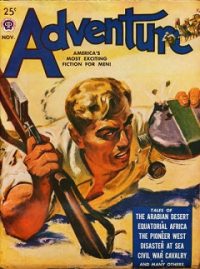
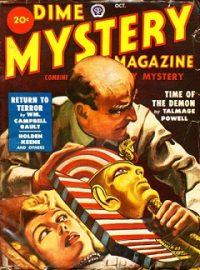
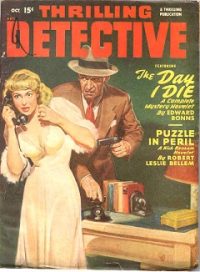
To view the entire list of weekly Old Time Radio episodes at Tangent Online, click here.